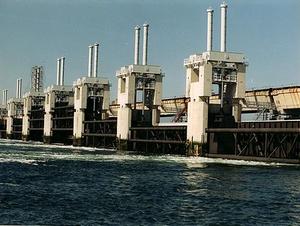Infrastructure protectionCities seek new ways to cope with sea level rise – and look to the Dutch for advice
Scientists predict a “tenfold increase” in the frequency of hurricanes and other storms, as well as sea-level rise of eleven to twenty-four inches within a little more than three decades – and planners and managers in U.S. coastal cities are looking at new ways to prepare their cities’ infrastructure for these challenges. In New York and New Orleans, city planners are studying the experience of the Dutch, who have gained a lot of experience – and fame — for their water control methods.

Water control brought the Dutch well-deserved fame // Source: uh.edu
City planners and managers are looking at new ways to prepare their cities’ infrastructure for rising sea levels and more frequent and intense natural disasters by 2050.
As Emergency Management reports, research from organizations such as the Niels Bohr Institute and others predicts a “tenfold increase” in the frequency of hurricanes and other storms, as well as sea-level rises of eleven to twenty-four inches within a little more than three decades.
Many of the largest coastal U.S. cities are, therefore, looking to revolutionize the ways in which they can protect themselves, and New Orleans and and New York are just two that are leading the charge.
In New Orleans, where residents still live in the shadows of the devastation from Hurricane Katrina in 2005, state officials are looking into new ways to invest in the strengthening of the city. In 2012, they released a $50 billion measure to assess and repair the state’s vulnerabilities to future disasters. Additionally, Greater New Orleans Inc., a regional economic development group, introduced the Urban Water Plan for the Orleans, Jefferson, and St. Bernard parishes.
“We need to address our water issues in a comprehensive way, recognizing that one solution alone is not going to work,” said Robin Barnes, the chief operating officer for Greater New Orleans. Their goal is to develop unique ways to manage the water within the city, and not just try to pump it out when a disaster strikes.
Barnes said that the plan is to peer into “forward-looking, urban design elements,” including “rain gardens and bio-swales” in addition to upgraded canals, ponds and higher levees. This more environmentally conscious approach would also include utilizing the region’s flora and fauna that already exist to also control the tides and flows of water.
In 2013, New York mayor Michael Bloomberg announced a similar plan in the shape of the $20 billion Storm Protection Plan, which includes over 250 recommendations that take an honest look at the shape of infrastructure in the city. Some of these include the widening and elevating of beaches and sand dunes, lining shorelines with massive rocks, and placing special breakers within the wave zones to decrease their force. Further, many buildings will be assessed and updated, especially those erected before 1961. Many of these ideas form the basis of the “Big U,” or the greater network of protective barriers that would ultimately encircle the perimeter of the city.
While each metropolis requires different approaches, both cities share the common element of employing the research and experience of the Dutch, who have gained a lot of experience – and fame — for their water control methods.
“The Dutch have 800 years of water management experience, so when we were developing our plans we looked closely at what they have done. We also looked at plans in other parts of the world in an effort to bring a number of the best practices back to New York,” said Dan Zarrilli, the director of the Mayor’s Office of Recovery and Resiliency.
Zarelli sums up the strategy of many American communities in response to climate change when he stated, “One big challenge we’ve run into is the perception among some that there is a silver bullet solution out there. But we’ve learned that the risks are too varied. We need to advance a broad range of strategies, which is exactly what we’re doing.”
